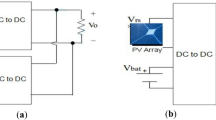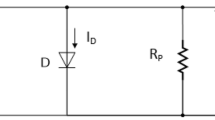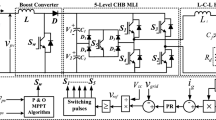Abstract
Several existing research studies on the modeling of photovoltaic (PV) systems feeding a resistive load through a DC-DC converter have proven that the use of the small-signal approach using analytical or graphical methods for the design of a linear model is failing. This is due to the fact that the simplified linear model, usually presented by a transfer function, is unable to reveal all the existing information about the actual solar system behavior when subjected to the Standard Test Conditions (STC). Since it does not take into account: (i) the nonlinearity of the current–voltage (I-V) characteristic of the solar panel, (ii) the presence of elementary components in both the solar panel and the DC-DC converter, which are often unmodeled and cannot be easily considered in the modeling, (iii) the existence of extra components in the DC-DC converter and more dynamics that must be neglected at high frequencies, for example those describing the thermal energies dissipated in the IGBT part of the DC-DC boost converter, the presence of cross-coupling between some electrical quantities occurring either in the DC-DC boost converter or in the solar panel, etc. For these reasons, this paper proposes a new design of a small-signal linear model to accurately describe the actual solar system behavior operating at STC. This is achieved by considering its internal functioning as a black box where only its input–output measurements are available in the form of frequency response data (FRD), generated by running a free stand-alone Plecs® software package. As this software has the ability to perfectly model the behavior of boost DC-DC converters, previously connected by variable resistive loads, it is possible thanks to the existence of equivalent electrical circuits, available in its own library. Unfortunately, this library lacks an equivalent circuit for the KC200GT photovoltaic panel where its design is needed through evaluating its current–voltage characteristics. The resulting global model is then simulated in the modified Plecs® software, providing the desired FRDs. These are used to estimate the parameters of the proposed linear model, which then used for tuning the PID controller. Here, this controller is combined with the standard Maximum Power Point Tracking (MPPT) strategy based on the direct implementation of the Incremental Conductance (INC) algorithm, highlighting therefore the proposed improved INC-MPPT strategy. It perfectly overcomes the ripple problems encountered in some electrical components of the solar system when controlled by the standard INC-MPPT strategy. As the proposed improvements depend on the model accuracy, the main contribution of this paper lies therefore on the necessary steps to design this proposed small-signal model.













Similar content being viewed by others
References
Femia, N.; Petrone, G.; Spagnuolo, G.; Vitelli, M.: Optimizing duty-cycle perturbation of P&O MPPT technique. In: 2004 IEEE 35th Annual Power Electronics Specialists Conference (IEEE Cat. No. 04CH37551) (2004), pp. 1939–1944. IEEE
Challa, D.T.R.; Raghavendar, I.: Implementation of incremental conductance MPPT with direct control method using cuk converter. Int. J. Mod. Eng. Res. (IJMER) 2(6), 4491–4496 (2012)
Mei, Q.; Shan, M.; Liu, L.; Guerrero, J.: A novel improved variable step-size a novel improved variable step-size method for PV systems. IEEE Trans. Ind. Electron. 58, 2427–2434 (2011)
Abdelsalam, A.K.; Massoud, A.M.; Ahmed, S.; Enjeti, P.N.: High-performance adaptive perturb and observe MPPT technique for photovoltaic-based microgrids. IEEE Trans. Power Electron. 26(4), 1010–1021 (2011)
Motahhir, S.; Chalh, A.; El Ghzizal, A.; Derouich, A.: Development of a low-cost PV system using an improved INC algorithm and a PV panel Proteus model. J. Clean. Prod. 204, 355–365 (2018)
Kumar, N.; Singh, B.; Panigrahi, B.K.: Integration of solar PV with low-voltage weak grid system: using maximize-M Kalman filter and self-tuned P&O algorithm. IEEE Trans. Industr. Electron. 66(11), 9013–9022 (2019)
Villalva, M.; De Siqueira, T.; Ruppert, E.: Voltage regulation of photovoltaic arrays: small-signal analysis and control design. IET Power Electronics 3(6), 869–880 (2010)
Anto, E.K.; Asumadu, J.A.; Okyere, P.Y.: PID-based P&O MPPT controller for offgrid solar PV systems using Ziegler-Nichols tuning method to step, ramp and impulse inputs. J. Multidiscip. Eng. Sci. Stud. (JMESS) 2(7), 669–680 (2016)
Haque, M.M.; Wolfs, P.; Alahakoon, S.: Small signal modeling and control of isolated three port DC-DC Converter for PV-battery system. In: 2017 IEEE Region 10 Humanitarian Technology Conference (R10-HTC) (2017), pp. 263–266. IEEE
Allmeling, J.H.; Hammer, W.P.: PLECS-piece-wise linear electrical circuit simulation for Simulink. In: Proceedings of the IEEE 1999 International Conference on Power Electronics and Drive Systems. PEDS’99 (Cat. No. 99TH8475) (1999), pp. 355–360. IEEE
Asadi, F.: Extraction of Small-Signal Transfer Functions Using PLECS® and MATLAB®. In: Computer Techniques for Dynamic Modeling of DC-DC Power Converters. pp. 1–37. Springer, (2018)
Zhang, K.; Shan, Z.; Jatskevich, J.: Large-and small-signal average-value modeling of dual-active-bridge DC–DC converter considering power losses. IEEE Trans. Power Electron. 32(3), 1964–1974 (2016)
Burgos-Mellado, C.; Costabeber, A.; Sumner, M.; Cárdenas-Dobson, R.; Sáez, D.: Small-signal modelling and stability assessment of phase-locked loops in weak grids. Energies 12(7), 1227 (2019)
Bechouat, M.; Sedraoui, M.; Feraga, C.-E.; Aidoud, M.; Kahla, S.: Modeling and fuzzy MPPT controller design for photovoltaic module equipped with a closed-loop cooling system. J. Electron. Mater. 48(9), 5471–5480 (2019)
Aissani, S.; Kahla, S.; Bechouat, M.; Amieur, T.; Sedraoui, M.: A Voltage PID Controller Synthesis Based on a New Small-Signal Linear Model to Enhance the Performance of the Standard P &O Algorithm Employed in Photovoltaic Panels. Arabian J. Sci. Eng. 1–16 (2022)
Kahla, S.; Bechouat, M.; Amieur, T.; Sedraoui, M.; Guessoum, H.: Enhanced the modeling accuracy by the design of new photovoltaic models including the proposed nonlinear thermal resistors. Int. J. Model. Simul. 1–16 (2022)
Bakar Siddique, M.A.; Asad, A.; Asif, R.M.; Rehman, A.U.; Sadiq, M.T.; Ullah, I.: Implementation of incremental conductance MPPT algorithm with integral regulator by using boost converter in grid-connected PV array. IETE J. Res. 1–14 (2021)
Feroz Mirza, A.; Mansoor, M.; Ling, Q.; Khan, M.I.; Aldossary, O.M.: Advanced variable step size incremental conductance MPPT for a standalone PV system utilizing a GA-tuned PID controller. Energies 13(16), 4153 (2020)
Jha, K.; Dahiya, R.: Comparative study of perturb & observe (P&O) and incremental conductance (IC) MPPT technique of PV system. In: Numerical Optimization in Engineering and Sciences: Select Proceedings of NOIEAS 2019 2020, pp. 191–199. Springer
Ali, A.I.M.; Alaas, Z.M.; Sayed, M.A.; Almalaq, A.; Farah, A.; Mohamed, M.A.: An efficient MPPT technique-based single-stage incremental conductance for integrated PV systems considering flyback central-type PV inverter. Sustainability 14(19), 12105 (2022)
Funding
This research received no specific grant from any funding agency in the public, commercial, or not-for-profit sectors.
Author information
Authors and Affiliations
Contributions
BM, SM and AS have contributed equally in the preparation of this manuscript.
Corresponding author
Ethics declarations
Conflict of interest
The authors reported no potential conflict of interest.
Rights and permissions
Springer Nature or its licensor (e.g. a society or other partner) holds exclusive rights to this article under a publishing agreement with the author(s) or other rightsholder(s); author self-archiving of the accepted manuscript version of this article is solely governed by the terms of such publishing agreement and applicable law.
About this article
Cite this article
Bechouat, M., Sedraoui, M. & Aissani, S. Improved INC-MPPT Strategy Based on New Small-Signal Design Model for Solar System Using Frequency Data Extracted Through Graphical Interface of Plecs® Software. Arab J Sci Eng 49, 7113–7126 (2024). https://doi.org/10.1007/s13369-023-08661-4
Received:
Accepted:
Published:
Issue Date:
DOI: https://doi.org/10.1007/s13369-023-08661-4








